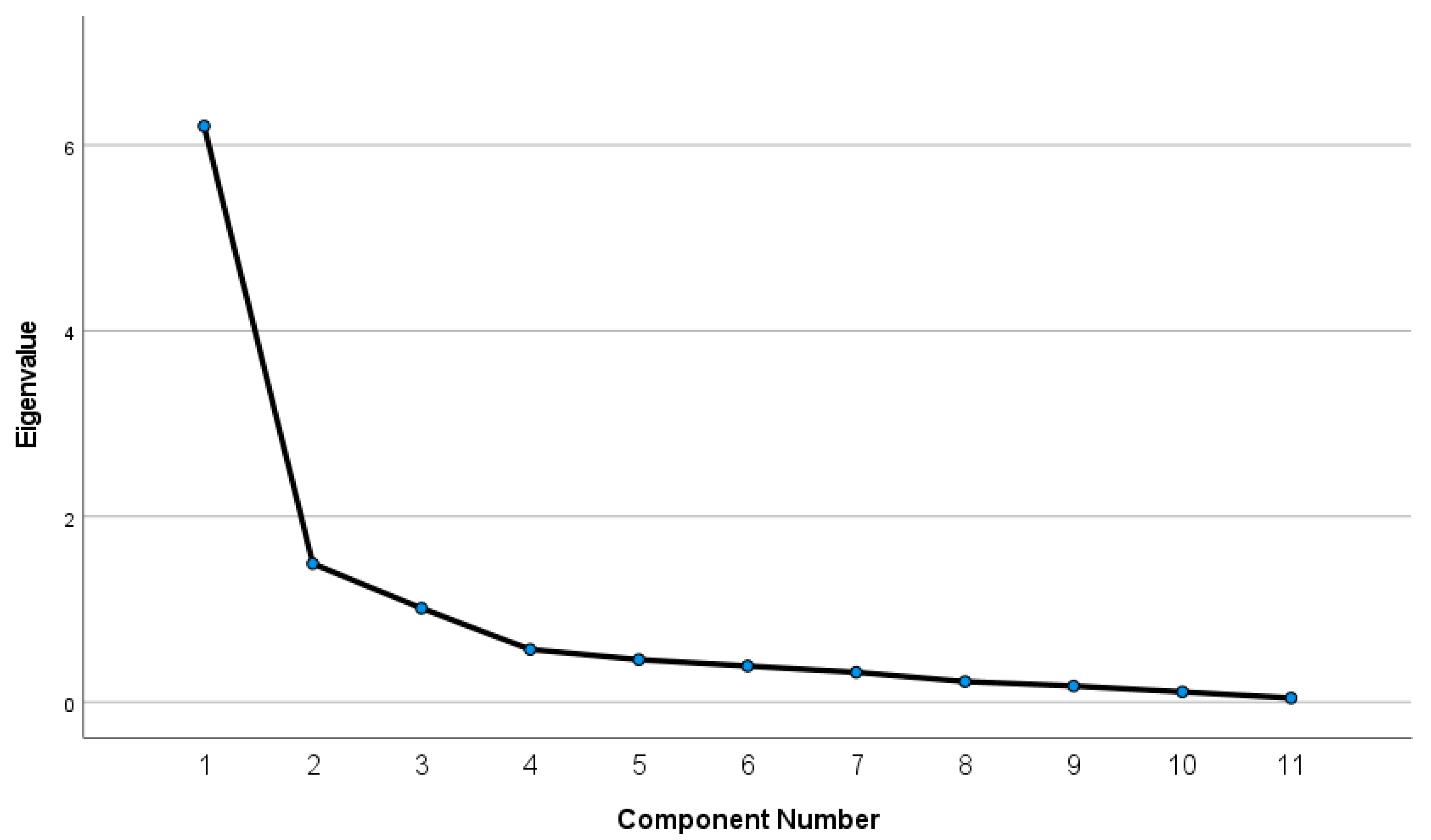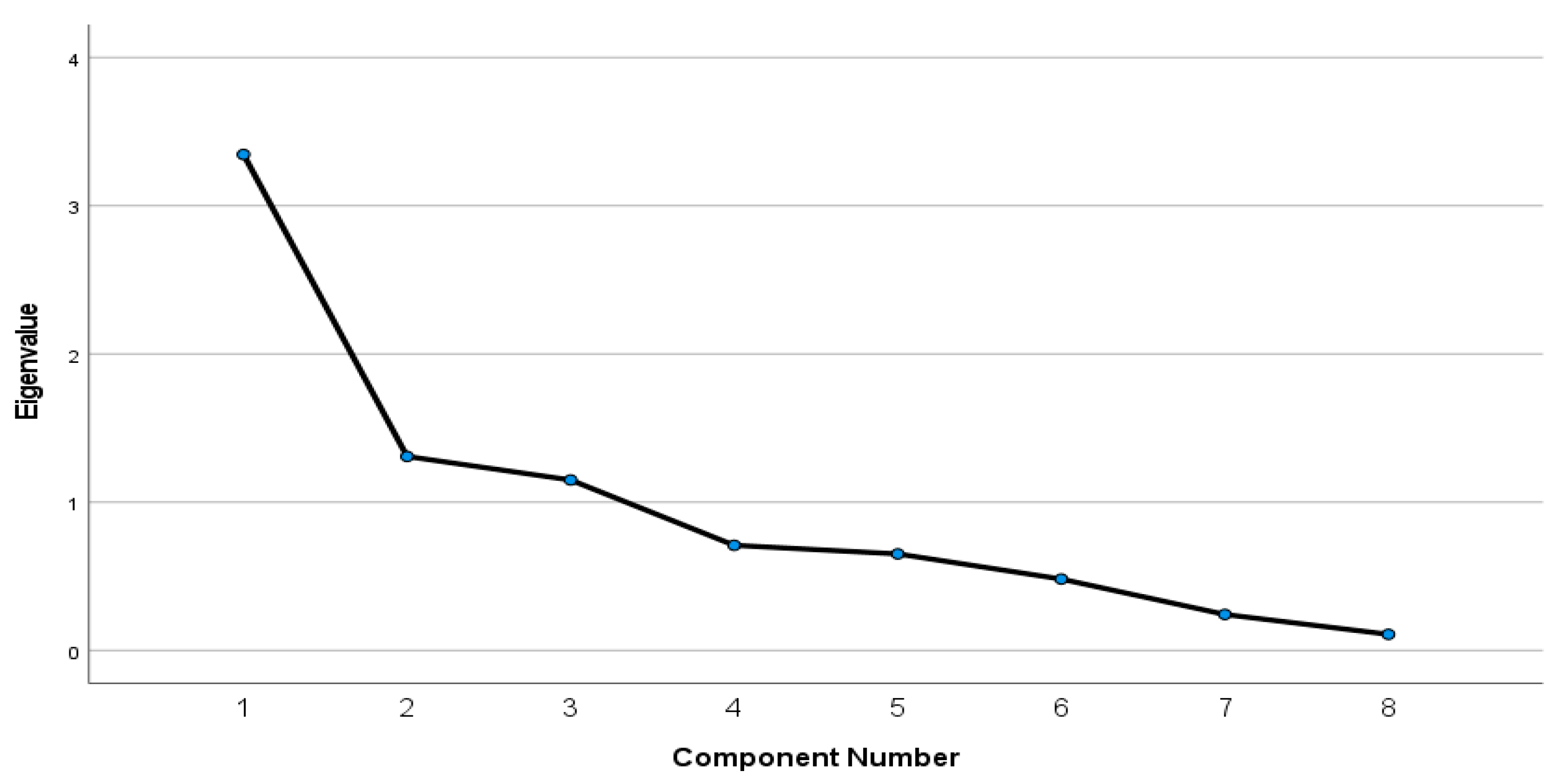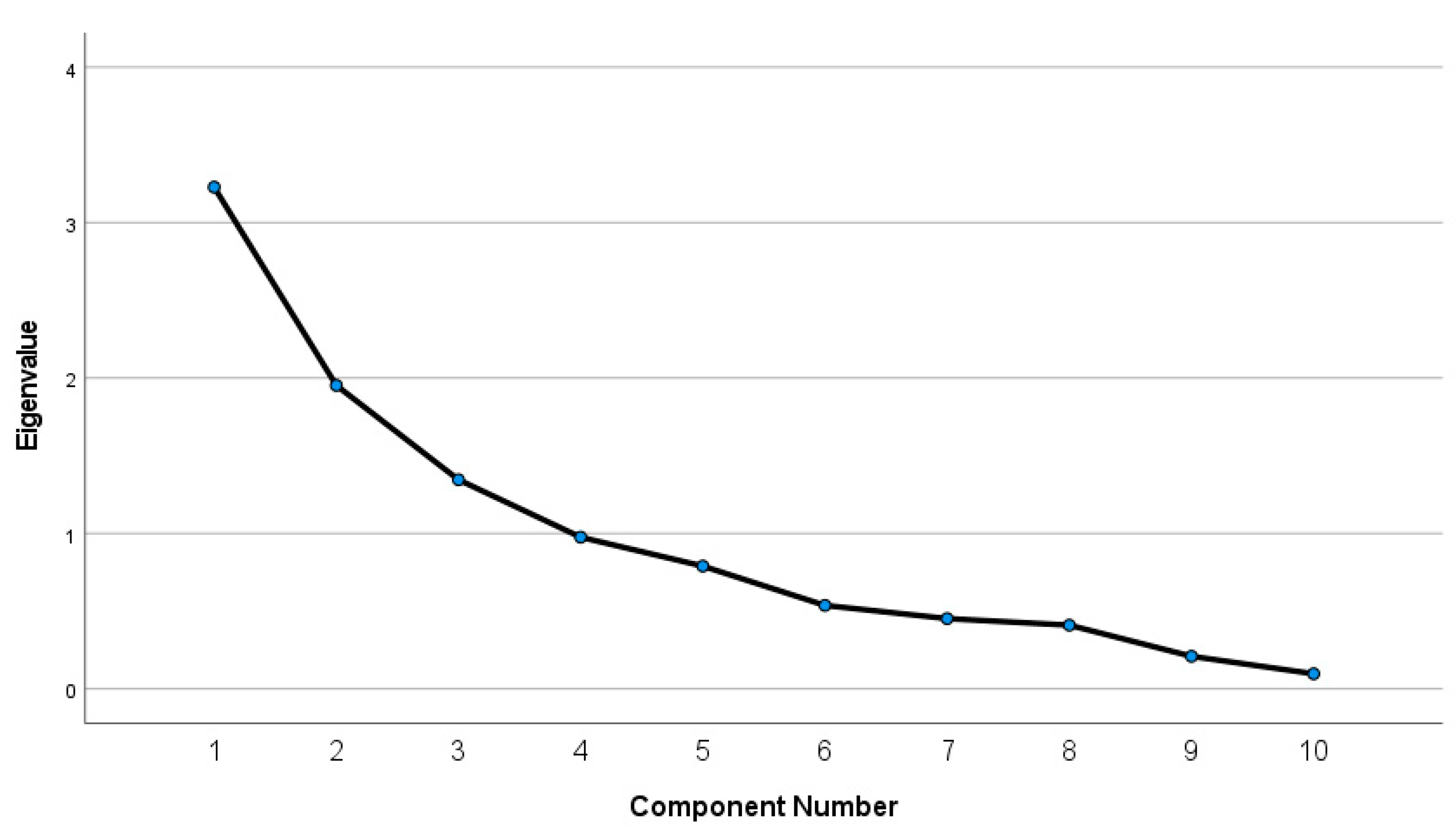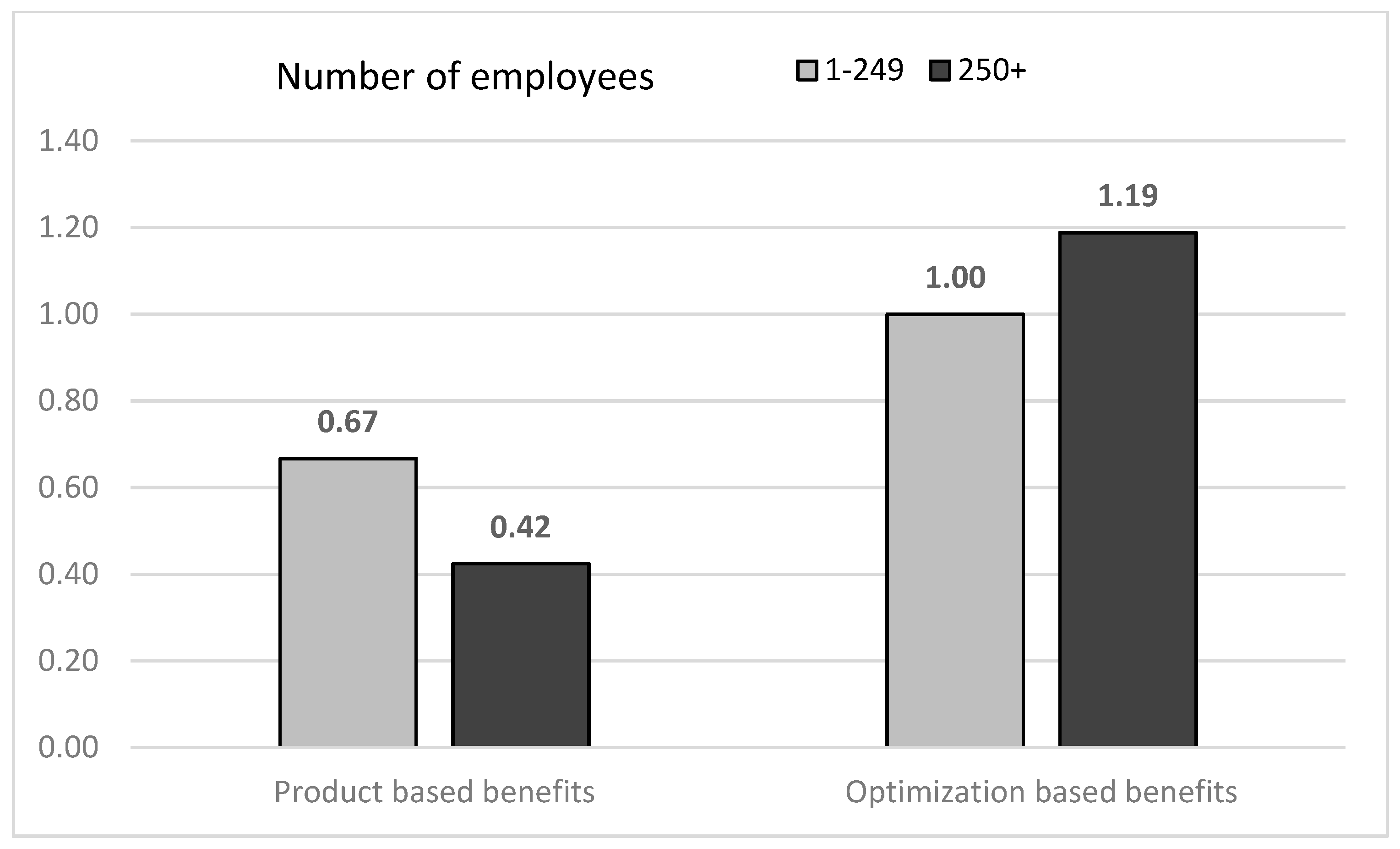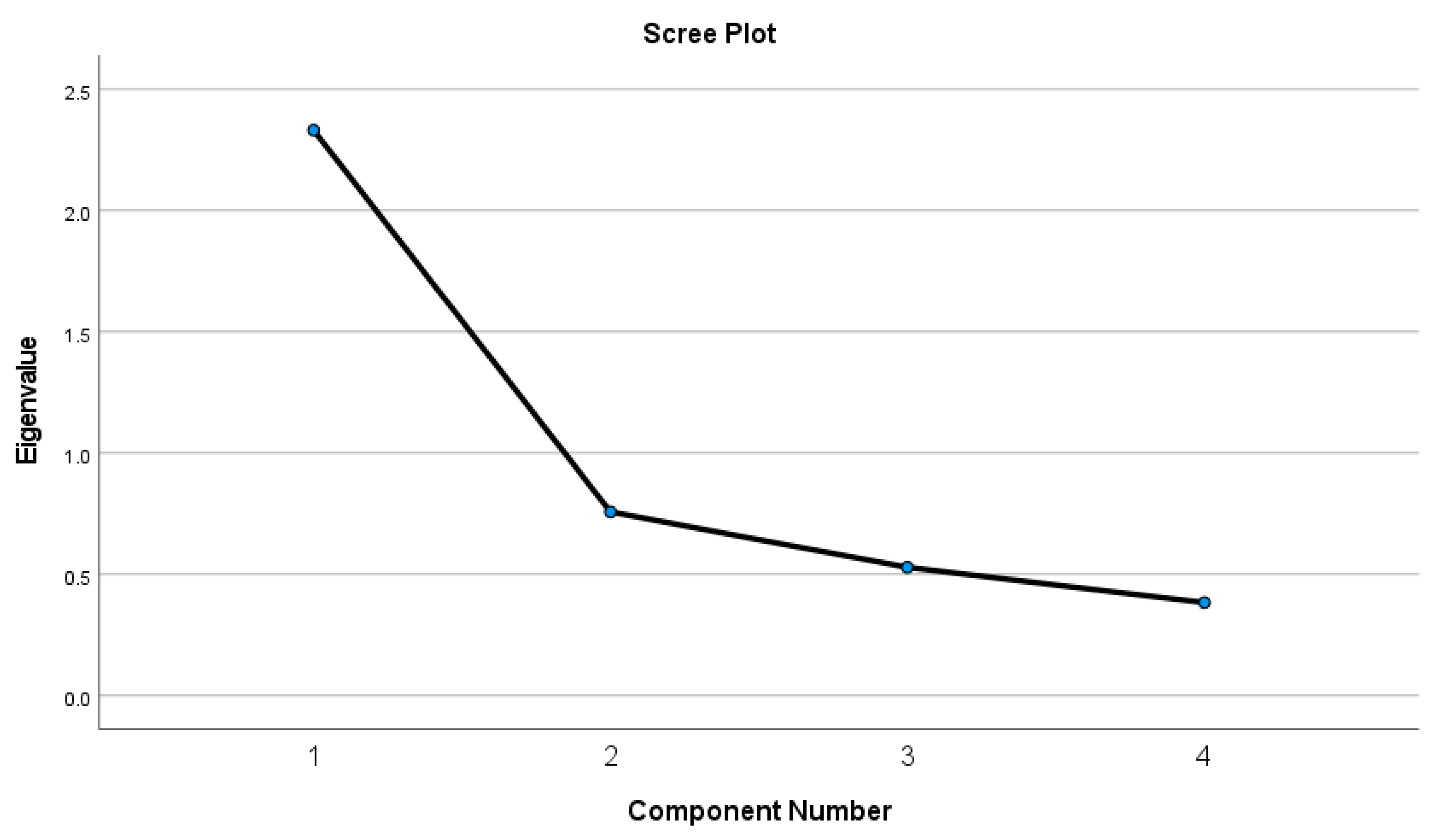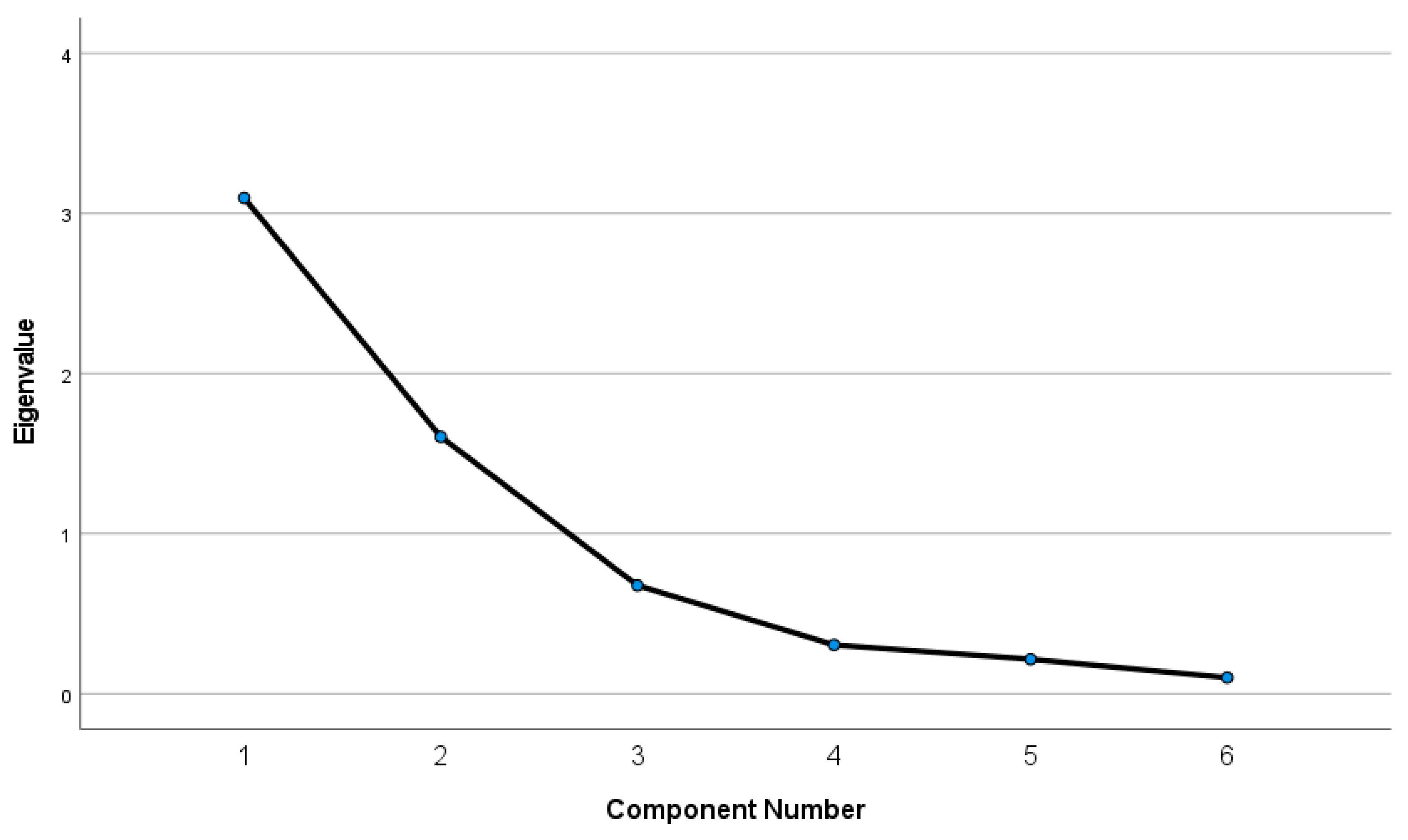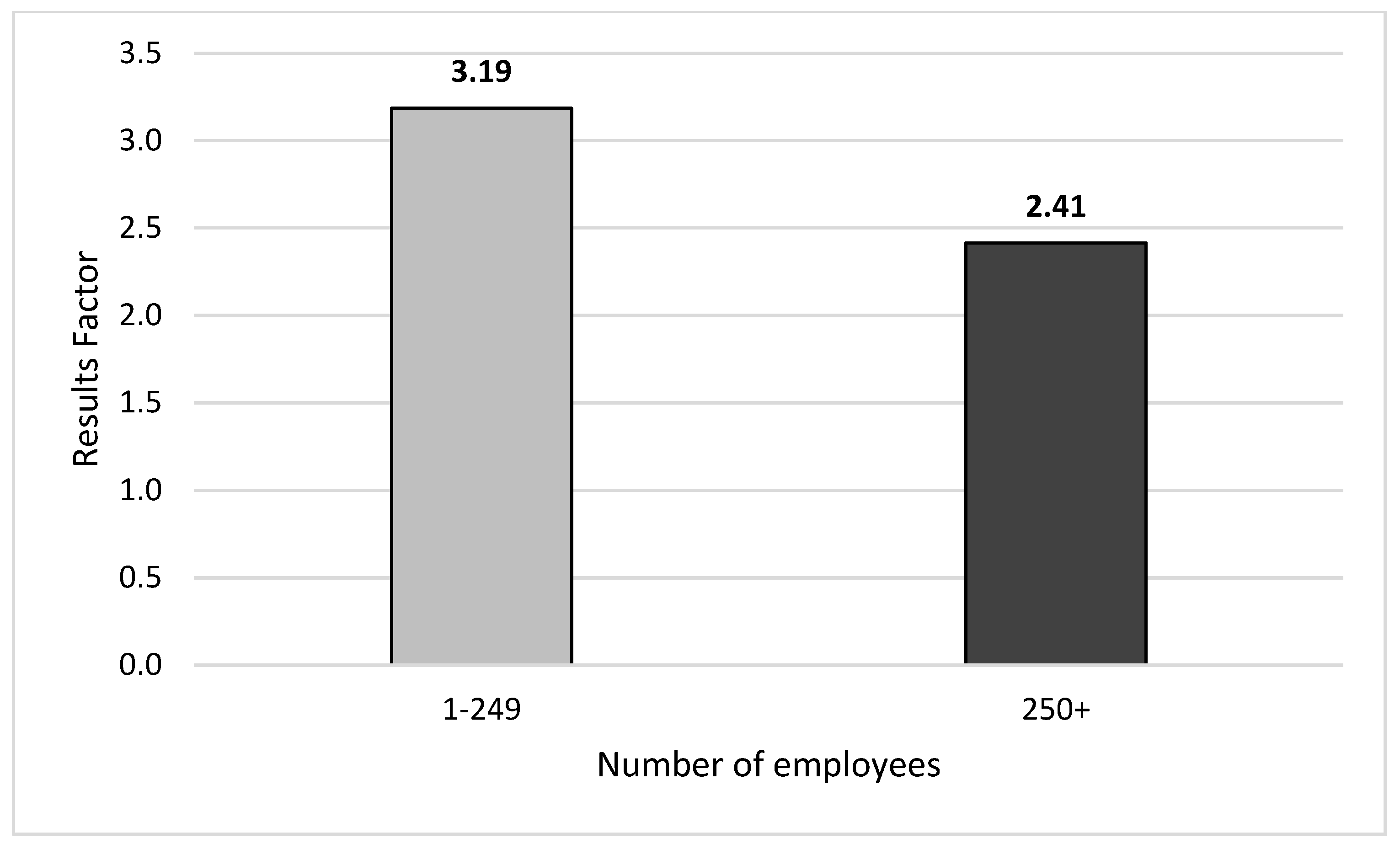1. Introduction
The global industrial landscape has changed profoundly in recent years. Efficiency, quality and flexibility are factors of production that determine not only financial results, but a company’s survival in a highly competitive environment (
Kovács 2020). For example, globalisation makes it possible for more efficient foreign companies to ‘steal’ a market from domestic companies (
Lopes et al. 2021). Researchers have indicated that in order to meet such challenges, Polish businesses must be technologically and financially prepared (
Vlčková et al. 2019) because the effectiveness of businesses depends on intense application of mechanical and human labour, especially in production where applications of machine labour are the most widespread (
Inshakova et al. 2020). Strategies and processes that reduce operating costs (
Genovese et al. 2014), however, must also be intelligent (
Leitao et al. 2016) and autonomous (
Bechtold et al. 2014), which means they must involve sustainable and renewable energy (
Tesch da Silva et al. 2020). Research into the consequences of the total automatisation of human capital and artificial intelligence in Industry 4.0 production has shown that optimisation is achieved by means of proactive management and the stimulation of automatisation (
Gashenko et al. 2020). Only a high level of automation and digitisation through the integration of machines, devices and production lines (
Rashid and Tjahjono 2016) will allow a production plant (
Anand and Ward 2004) to achieve the level of flexibility necessary to develop in a competitive global environment. In recent years, progress in production and technological processes has occurred alongside new global concepts known as the ‘Fourth Industrial Revolution’, also known as Industry 4.0, Smart Industry, Smart Manufacturing, Integrated Industry or the Industrial Internet of Things (
Müller and Däschle 2018). Industry 4.0 should be placed alongside the three industrial revolutions that have taken place in recent centuries and represent major breakthroughs in production (
Schmidt et al. 2015). The first industrial revolution, in the mid-18th century, was made possible by the invention of the steam engine in England. The second revolution marked the use of electricity and the beginning of mass production in the 19th century. The third revolution was brought about by automation in production processes. The fourth industrial revolution is based on the concept of continuous communication exchange not only between man and machine but directly between machines (
Cooper and James 2009). It is worth emphasizing that technological changes progress dynamically. The first industrial revolution took centuries to develop. The second revolution took about 100 years. The third was introduced after 70 years, and 30–40 years later, Industry 4.0 was already being talked about. The technology is still progressing, and a fifth industrial revolution can be expected soon (
Nowotarski and Paslawski 2017).
Implementation of the solutions related to Industry 4.0 are a challenge for Polish industrial enterprises, regardless of size or affiliation to a larger, international organisation. Therefore, the aim of this research is to present the level of awareness, readiness and ability that Polish enterprises need in order to identify what they need to know to increase their knowledge about Industry 4.0.
The purpose of this study, conducted on a group of 60 randomly selected representatives of industrial companies operating in Poland, is to examine the awareness, readiness and ability of enterprises to meet the challenge of implementing the solutions related to Industry 4.0. The results showed that it is possible to identify the implications of implementation, including the need for additional support to address technological, financial and human resources challenges.
This article is organised into six parts.
Section 1 is an introduction;
Section 2 is a literature review;
Section 3 describes the research methodology;
Section 4 presents the research results;
Section 5 discusses the results; and
Section 6 presents the main findings, theoretical and practical implications, study limitations and future lines of research.
2. Literature Review
Our highly competitive global business environment shapes Industry 4.0, which is likely to change the way entire industries design, plan, produce and deliver goods (
Stock and Seliger 2016). The concept of Industry 4.0 first appeared as a result of the high-tech strategy for 2020 initiated by the German government in 2011 (
Zhou et al. 2016) and is based on earlier concepts that evolved over the years (
Kagermann 2015). Although technological innovations such as sensors and automation have been used by manufacturing companies for many years, limited connectivity and integration between the technologies used in manufacturing and enterprise systems (
Veeramani et al. 1995) meant that their potential was not fully exploited (
Li 2011;
Naqvi et al. 2015). The Industry 4.0 concept includes the full use of a set of electronics and information technologies in the field of cyberphysical systems (CPS), intelligent robots, the Internet of Things (IoT), the Internet of Services (IoS), big data, augmented reality and digital manufacturing. These machines, devices, production lines and products can independently exchange information, initiate actions and control each other, thus enabling the creation of an intelligent production environment, which is crucial for the development of smarter production processes (
Weyer et al. 2015;
Vaníčková and Szczepańska-Woszczyna 2020). The Fourth Industrial Revolution connects the physical and digital worlds in a way that allows for improving the efficiency and effectiveness of industrial enterprises. This creates a huge set of economic and social opportunities, especially in the field of production technology and work organisation (
Kagermann et al. 2013).
The key technologies framing the concept of Industry 4.0 are: intelligent sensors/cyberphysical systems (CPS), the Internet of Things (IoT), the Internet of Services (IoS), big data, intelligent robots, augmented reality, 3D printing and fraud prevention and detection systems.
Intelligent sensors/cyberphysical systems (CPS) are mechanisms controlled or monitored by computer algorithms, tightly integrated with the Internet and its users and, as such, constitute a basic element of Industry 4.0 (
Posada et al. 2015). In CPS, physical and software components are closely related, each operating on a different spatial and temporal scale, exhibiting many different behavioural modalities and interacting in many ways that change with context. Cyberphysical systems, by integrating the physical and computing environment (
Lee et al. 2015), provide access to data and its processing (
Monostori et al. 2016) and enable many innovative applications, including an innovative approach to the business model itself (
Hellinger and Seeger 2011;
Reischauer and Leitner 2016). Combining CPS with production allows for the horizontal and vertical integration of IT systems, transforming today’s factories into Industry 4.0 factories. The Internet of Things (IoT) is a term that describes the combination of different technologies based on the exchange of data between physical things and the Internet. The technological development of the Internet made it possible to expand from connections between computers to the connection of intelligent objects (
Kopetz 2011), enabling not only a collection of information but also an interaction with the environment through data exchange and running processes over the Internet. In industrial enterprises, we define IoT as an Internet connection between physical objects, people and systems located in the production hall. In the industrial environment, IoT has a huge impact on production and its automation, logistics and business process management (
Atzori et al. 2010;
Miorandi et al. 2012) through the use of breakthrough technologies such as sensors, actuators, data analysis, control systems and security mechanisms (
Mourtzis et al. 2016). The production environment created in this way is called the Smart Factory (
Shariatzadeh et al. 2016). In such a system, it is possible to interact between objects via the Internet, checking their status and all related information while accounting for security and privacy issues (
Haller et al. 2008;
Ashton 2009). According to Cardoso, IoT applications can be divided into three main pillars: process optimisation, resource optimisation and complex autonomous systems (
Cardoso et al. 2008). The Internet of Services (IoS) emerged recently and is the equivalent of IoT in the service industry, providing the business and technical basis for creating business networks connecting service providers with customers. IoS enables the improvement of relations between suppliers, aggregators, service providers and customers by changing the way of providing services and raising their quality to a new, higher level (
Schmidt et al. 2015;
Pereira and Romero 2017). Big data is often seen as a catchword for data analysis, but it more so creates new products or services and responds to business changes as they occur (
Davenport et al. 2012). There are a set of big data definitions that highlight different aspects of the concept. Some focus more on the variety aspect of data sources; others emphasise storage and analysis requirements. Wamba defines big data as a holistic approach to manage, process and analyse the five Vs (i.e., value, volume, variety, veracity and velocity) in order to create competitive advantages (
Wamba et al. 2015). Intelligent robots in industry are robots that, thanks to the use of artificial intelligence, have the ability to learn and think logically and autonomously, performing more complex tasks with greater efficiency, without being dependent on programs written by people (
Wang et al. 2016). Intelligent robots are also connected with modelling and simulation (M&S), which is one of the basic tools for modelling future deterministic or unexpected stochastic events and defining the optimal scenario for operations. (
Cservenák et al. 2014;
Dudás 2010;
Straka et al. 2014). Thanks to the integration of, among others, autonomous robots, IoT, big data, cloud computing and simulations of complex digital production systems (
Gubán et al. 2017), factories can self-organise and optimise their own production activities, making them more competitive (
Lee et al. 2015). Augmented reality (hereinafter AR) is defined as combining real and virtual objects in a real environment, interactively and in real time, to geometrically align virtual and real objects in the real world (
Azuma et al. 2001). In order to keep up with the technology development of automated production systems (
Romero et al. 2016), the workforce requires the implementation of solutions that increase the efficiency of labour. In response to these expectations, systems connecting the real world with the computer-generated world have been developed. A widely used solution is the use of AR applications in special training glasses that combine virtual and real working environments and assist the workers in the production process. Three-dimensional printing is one of the latest production technologies that allows for the generation of highly personalised products thanks to the combination of computers, machines and business processes (
Zhong et al. 2015). Three-dimensional printing enables the production of highly customised products in small quantities while ensuring their quality and profitability. This ability can bring huge improvements in efficiency and productivity, allowing industrial enterprises to personalise the production processes. This makes it possible to implement flexible production strategies and business processes aimed at producing personalised mass products (
Brecher et al. 2011). Fraud prevention and detection systems are used not only in the financial industry but also in the industrial enterprises. There are two basic types of these systems—fraud prevention systems (FPS) and fraud detection systems (FDS). FPS focuses primarily on preventing cyberattacks in computer systems, device networks and databases, using various types of encryption algorithms and firewalls. FDS replaces time-consuming, manual techniques for monitoring transactions and processes by aggregating data and knowledge in finance, economics and business. Data mining includes statistical techniques, mathematics, artificial intelligence and machine learning to identify fraud, indicate the likelihood of fraud or define new types of fraud (
Abdallah et al. 2016).
Industry 4.0 is a huge set of economic and social opportunities that creates new business models tailored to the needs of customers, allowing for the increase of production flexibility and ultimately international competitiveness, especially important in an industrialised country such as Poland. The globalisation of economies allows no room for a technological gap both between corporate branches in different locations internationally and between large enterprises and SMEs cooperating with them locally, which are commonly perceived as important elements in stimulating and stabilising global economic growth (
Mokhtar et al. 2020;
Szczepańska-Woszczyna and Kurowska-Pysz 2016). In order to fully use the possibilities of Industry 4.0 in production plants located in Poland, the implementation should also take place in SMEs cooperating with these plants.
In relation to the impact of Industry 4.0, according to research by Vrchota and Pech, 65.7% of companies in the Czech Republic have already started implementing Industry 4.0 (
Vrchota and Pech 2019). According to the analysis by Ganzarain and Errasti on a representative sample of SMEs in the Basque Country, only a few companies use holistic Industry 4.0 methodology. (
Ganzarain and Errasti 2016). The review of nine studies of German manufacturing enterprises by Lutz Sommer showed that there is an awareness concerning the relevance of Industry 4.0. The readiness and the capability to meet this challenge depends strongly on the size of an enterprise. The smaller the SME, the higher the risk that they will become victims instead of beneficiaries of this revolution (
Sommer 2015). Studies in Germany have shown that between 68% of companies (
Schulze 2014) and 82% of companies (
Sommer 2015) are ready to implement Industry 4.0 solutions. The results of the benchmark study by Machado et al. indicates that the majority of Swedish companies are at an overall level similar to that of German manufacturing industries. The results indicate that companies need to increase efforts on training and identifying key competences (
Machado et al. 2019).
Based on the above literature, we hypothesise the differences in the level of knowledge of Polish industrial enterprises of Industry 4.0 solutions depending on their size. Hence, the hypothesis concerning the differences in the current level of knowledge is as follows:
Hypothesis 1. The level of knowledge of Polish industrial enterprises in the field of Industry 4.0 varies depending on their size.
The question is how well prepared the industrial plants (including SMEs) located in Poland are to face the Fourth Industrial Revolution. The question of what qualifications are necessary for the proper implementation of Industry 4.0 solutions should also be asked. Similar questions have already been asked by Polish researchers who, based on the analysis of secondary sources, indicated the low maturity of domestic small- and medium-sized enterprises to implement Industry 4.0 solutions (
Ślusarczyk and Pypłacz 2020).
In view of the above, researchers ask whether enterprises in Poland are able to effectively benefit from the achievements of the Fourth Industrial Revolution, or whether they will become its victims due to the lack of the ability to adapt.
3. Research Methodology
The study was conducted to examine the level of awareness, readiness and ability of enterprises located in Poland to implement Industry 4.0 solutions. To collect the data, a structured interview was used, carried out using the CAWI (computer-assisted web interview) method, consisting of 32 questions divided into research areas in the field of the technological competences of the respondents and suppliers of Industry 4.0 solutions. Some of the questions were modelled on the research conducted by
Ślusarczyk (
2018) and
Ślusarczyk and Pypłacz (
2020). Based on abovementioned studies as well as considering our experience, it was decided to determine answers to the following research questions:
To what extent is the Industry 4.0 concept known to representatives of industrial enterprises operating in Poland?
What technological solutions covering the Fourth Industrial Revolution are known to representatives of industrial enterprises operating in Poland?
What barriers to implementation of Industry 4.0 solutions are known to representatives of industrial enterprises operating in Poland?
What benefits of implementing Industry 4.0 solutions are known to representatives of industrial enterprises operating in Poland?
Who should be involved in the decision-making process to implement Industry 4.0 solutions?
Who should be responsible for the implementation of Industry 4.0 solutions?
Do the development strategies of enterprises operating in Poland include the implementation of Industry 4.0 solutions in the next 5 years?
In your opinion, what elements could support the decision-making process regarding the implementation of Industry 4.0 solutions in the enterprise and to what extent could those elements support it?
To what extent do smaller companies employing up to 249 employees differ from companies employing at least 250 employees in terms of: perceived technological competences; barriers to implementing Industry 4.0 solutions; benefits in implementing Industry 4.0 solutions; degree of business unit responsibility for the implementation of Industry 4.0 solutions; degree of support for the decision-making process to implement Industry 4.0 solutions?
The interview was conducted in January 2021 on a group of 60 randomly selected industrial companies representing industries in accordance with the leading profile of the company’s activity according to the Statistical Classification of Economic Activities used in the European Community: division C Industrial Processing of the European Classification of Activities (EKD). Rev. 2 (NACE Rev. 2-Statistical classification of economic activities. In 2002, a major revision of NACE was launched. The Regulation establishing NACE Rev. 2 is to be used, in general, for statistics referring to economic activities performed as from 1 January 2008 onwards),
Table 1 below.
At the request of the representatives of the respondent companies, the names of the surveyed companies were not disclosed.
In the analysed enterprises, the questions were answered by owners/directors, senior and middle-level managers, R&D departments and plant management as well as specialists in the field of technical service. The division of respondents, depending on the size of the company, is presented in
Figure 1 below.
Out of 60 companies included in the study, 27 companies (45.0%) employed up to 249 employers, and 33 companies (55.0%) employed at least 250 employers.
The survey consisted of 32 questions, was divided into areas according to the scope of the research described above and was conducted by using the CAWI method. The answers were given on a five-point Likert scale, in which different grades had the following meanings: 1 = no impact/knowledge; 2 = low impact/knowledge; 3 = neutral impact/knowledge; 4 = high impact/knowledge; and 5 = very high impact/knowledge.
Taking into account the fact that the decision to implement new technological solutions is influenced by the knowledge of decision makers, it was examined whether this knowledge depends on the size of the company and the position of the decision maker in the company. This is due to the fact that enterprises—in particular SMEs—have limited resources, which significantly hinders their decision-making process or causes wrong decisions. (
Edvardsson and Durst 2013). Moreover, the ability of enterprises to develop and innovate depends on the knowledge and vision of their managers (
Camisón-Haba et al. 2019).
The Likert scales are ordinal scales unless the results are summed up measuring the underlying latent construct. Therefore, statistical differences between companies employing up to 249 participants and companies employing at least 250 participants were verified with the use of the Mann–Whitney U test, which is a nonparametric statistical test allowing for comparisons between two independent groups of observations in terms of variables measured on ordinal scales. The Likert scales were also analysed with the use of principal component analysis. The extracted factors were also compared between companies employing up to 249 participants and companies employing at least 250 participants.
4. Research Results
The concept of the Fourth Industrial Revolution, especially under the name of Industry 4.0, is widely discussed. The definition of Industry 4.0 remains open. Despite growing interest in the subject, there is still no clear vision of its paradigm. Industry 4.0 can be understood as a common term for technologies and concepts that cover the entire value chain of an organisation (
Hermann et al. 2016). The new industrial paradigm also includes the development of intelligent environments that are able to connect the real and virtual worlds by integrating devices, machines and production lines that control each other autonomously (
Weyer et al. 2015). From a technical point of view, the industrial paradigm can be described as increased communication creating a value chain through the digitisation and automation of the production environment (
Oesterreich and Teuteberg 2016). All of these views are reflected in respondents’ answers. Moreover, despite the fact that all respondents have heard both about the concept itself and about selected technological solutions (
Table 2 below), most companies are not aware of the challenges posed by the willingness to implement Industry 4.0 solutions.
The results of the analysis and the conducted empirical research showed an insufficient state of knowledge in the field of technological solutions, as well as insufficient awareness of the possibilities of support in the field of enterprise development by technology suppliers. At the time of the survey, only five companies had implemented Industry 4.0 technologies, which constitutes 8.33% of the surveyed enterprises.
The results of the assessment of the knowledge of the respondents in the field of innovative technologies are presented in
Table 2 below. The strength of the knowledge of the respondents about the technology was assessed using a five-point Likert scale, in which different ratings had the following meaning: 1 = lack of knowledge; 2 = low level of knowledge; 3 = neutral level of knowledge; 4 = high level of knowledge; and 5 = a significant level of knowledge.
The research results indicate that the most well-known technological solutions among the respondents are: intelligent robots, 3D printing, intelligent sensors and the widely understood use of IoT. The least knowledge was shown by the respondents in the field of advanced customer interaction technology as well fraud detection. Further analysis of the answers also showed that regardless of the size of the company, the industry in which it operates or the position held by the respondent, over 78% of respondents do not know what technology providers offer in the field of Industry 4.0. Less than 22% of the respondents had contact with providers of advanced technological solutions, but they were not able to provide details. Importantly, among 60 respondents, when asked about the willingness to cooperate with technology suppliers in the field of Industry 4.0, only one company expressed interest.
Table 3 presents mean values acquired from the Likert scales regarding the respondents’ knowledge about innovative technologies in companies employing up to 249 participants and in companies employing at least 250 participants with the values of the Mann–Whitney U test.
The assessment of technological competencies regarding cloud computing, advanced interaction with customers and fraud detection was significantly higher in companies employing up to 249 employees.
The results on the Likert scales were also analysed with the use of principal component analysis with oblique Oblimin rotation. The acquired scree plot is depicted in
Figure 2.
Based on the Kaiser criterion, three components were extracted.
Table 4 presents factor loadings in a pattern matrix. The values lower than 0.4 were suppressed for clarity.
Based on the factor loadings, two factors were extracted. The third component was discarded because it did not contain items with factor loadings higher than the factor loadings on the other two factors. Taking the items’ contents into consideration, the first factor was named ‘Human-based competencies’, and the second factor was named ‘Equipment-based competencies’. According to the values of the independent samples t-test, there were no statistically significant differences between companies employing 1–249 workers and companies employing at least 250 workers regarding human-based competencies, t (38.93) = 1.12, p > 0.05, or regarding equipment competencies, t (58) = −1.46, p > 0.05.
As indicated by the results of the research presented in
Table 5 below, the respondents pointed out the following aspects as the greatest barriers in the implementation of Industry 4.0 solutions: ‘Problems with appropriately qualified staff’ (44 respondents) and ‘Problems with technical integration’ (43 respondents). The barriers with the least impact on the implementation of Industry 4.0 solutions were considered by the respondents as: ‘Insufficient financial resources’ (15 respondents) and ‘Resistance in the organisation against implementing Industry 4.0 solutions’ (17 respondents).
Table 6 presents mean values acquired from the Likert scales regarding barriers to implementing Industry 4.0 solutions in companies employing up to 249 participants and in companies employing at least 250 participants with the values of the Mann–Whitney U test.
The assessment of barriers regarding standardisation problems was significantly higher in companies employing at least 250 employees.
The results on the Likert scales were also analysed with the use of principal component analysis with oblique Oblimin rotation. The acquired scree plot is depicted in
Figure 3.
Based on the Kaiser criterion, three components were extracted.
Table 7 presents factor loadings in a pattern matrix. The values lower than 0.4 were suppressed for clarity.
Based on the factor loadings, two factors were extracted. The second component was discarded because it was based only on two items. Taking the items’ contents into consideration, the first factor was named ‘Organisational barriers’ and the third factor was named ‘Implementation barriers’. According to the values of the independent samples t-test, there were no statistically significant differences between companies employing 1–249 workers and companies employing at least 250 workers regarding organisational barriers, t (58) = −0.50, p > 0.05, and regarding implementation barriers, t (58) = 1.69, p > 0.05.
According to the given responses (
Table 8 below), the respondents considered the greatest benefits of implementing Industry 4.0 solutions as: ‘Optimisation of automation processes’ (53 respondents), ‘Increasing the efficiency of energy consumption” (44 respondents), ‘Increasing product quality ‘(38 respondents) and ‘Increasing productivity’ (37 respondents). The smallest benefits from the implementation of Industry 4.0 solutions were considered by the respondents as: ‘Support for the decision-making process’ (9 respondents) and ‘Support for sustainable development’ (10 respondents).
Table 9 presents mean values acquired from the Likert scales regarding benefits in implementing Industry 4.0 solutions in companies employing up to 249 participants and in companies employing at least 250 participants with the values of the Mann–Whitney U test.
The assessment of the optimisation of automation processes was significantly higher in companies employing at least 250 employees. The assessment of product quality improvement was significantly higher in companies employing up to 249 employees.
The results from the Likert scales were also analysed with the use of principal component analysis with oblique Oblimin rotation. The acquired scree plot is depicted in
Figure 4.
Based on the Kaiser criterion, three components were extracted.
Table 10 presents factor loadings in a pattern matrix. The values lower than 0.4 were suppressed for clarity.
Based on the factor loadings, two factors were extracted. Taking the items’ contents into consideration, the first factor was named ‘Product-based benefits’ and the second factor was named ‘Optimisation-based benefits’. The third factor was discarded because it was based on only two items. According to the values of the independent samples t-test, there were statistically significant differences between companies employing 1–249 workers and companies employing at least 250 workers regarding both product-based benefits,
t (57.98) = 2.20,
p < 0.05, and optimisation-based benefits,
t (58) = −2.08,
p < 0.05. The mean value of product-based benefits was higher in smaller companies, while that of optimisation-based benefits was higher in larger companies (see
Figure 5).
The research results (
Table 11 below) showed that according to the respondents, the following persons should be involved in the decision-making process, in particular: the Management Board (25 respondents) and the head of the department concerned with the given solution (23 respondents). All respondents indicated at least one person/department who, according to the respondents, should be involved in the decision-making process on the implementation of Industry 4.0 solutions.
The units and the degree of their responsibility for the implementation of Industry 4.0 solutions are presented in
Table 12 below. Questioned as to who should be responsible for the implementation of Industry 4.0 solutions and to what extent they should be responsible, the respondents made an assessment using a five-point Likert scale, in which different assessments had the following meanings: 1 = bears no responsibility; 2 = has little responsibility; 3 = indicates a neutral level of responsibility; 4 = means a high level of responsibility; 5 = bears significant responsibility. Thirty-seven respondents marked the answer ‘Other’ without indicating specific units responsible for the implementation, making the answer dependent on the implemented technology.
Table 13 presents the mean values acquired from the Likert scales regarding the degree of unit responsibility for the implementation of Industry 4.0 solutions in companies employing up to 249 participants and in companies employing at least 250 participants with the values of the Mann–Whitney U test.
The assessment of management board responsibility was significantly lower in companies employing at least 250 employees.
The results from the Likert scales were also analysed with the use of principal component analysis with oblique Oblimin rotation. The acquired scree plot, which shows the eigenvalues on the
y-axis and the number of factors on the
x-axis and is used to determine the number of factors to retain is depicted on
Figure 6.
Based on the Kaiser criterion, only one component was extracted. According to the value of the independent samples t-test there was no statistically significant difference between larger and smaller companies regarding the total responsibility score t(58) = 1.37, p > 0.05.
According to the conducted research, a significant number of respondents (41) do not have information about planned investments in technologies in the field of Industry 4.0. This means that enterprises do not plan such investments in the next 5 years, or the respondents are not a unit or part of the working group responsible for the development/implementation of the enterprise development strategy. Ten companies out of sixty surveyed, planning to implement Industry 4.0 solutions in the next 5 years, indicate little awareness of the importance of the topic.
According to the respondents’ answers (
Table 14 below), only 16.67% of enterprises include the implementation of Industry 4.0 solutions in their strategy for the next 5 years. Therefore, an additional important determinant was included to indicate the elements supporting the decision of Industry 4.0 implementation as well as the degree to which these elements support the decision process (
Table 15 below). The answers were assessed by the respondents using a five-point Likert scale in which different ratings had the following meaning: 1 = means the minimum level of support; 2 = means a low level of support; 3 = means neutral support level; 4 = indicates a high level of support; 5 = means a significant level of support. The survey results indicate that there is no agreement among the respondents as to the degree of support for individual elements impacting the decision to implement Industry 4.0 solutions. For the five items comprising the question, scores above the average prevail; in the case of the item, ‘Determining individual implementation results for the enterprise’, scores below the average of the scale used prevail.
Table 16 presents mean values acquired on the Likert scales regarding the degree of support for the decision-making process to implement Industry 4.0 solutions in companies employing up to 249 participants and in companies employing at least 250 participants with the values of the Mann–Whitney U test.
The assessment for the case study in the same industry was significantly higher in companies employing at least 250 employees. The assessment for establishing individual implementation results for the company and support of a consulting company/expert in the implementation was significantly higher in companies employing up to 249 employees.
The results from the Likert scales were also analysed with the use of principal component analysis with oblique Oblimin rotation. The acquired scree plot is depicted in
Figure 7.
Based on the Kaiser criterion, two components were extracted.
Table 17 presents factor loadings in a pattern matrix. The values lower than 0.4 were suppressed for clarity. This exclusion ensures that the factor loadings will be higher than the minimal level for interpretation of structure, which is considered to be in the range 0.30 to ± 0.40 (
Hair et al. 2019).
Based on the factor loadings, two factors were extracted. Taking the items’ contents into consideration, the first factor was named ‘Results Factor’, and the second factor was named ‘Knowledge Factor’.
According to the values of the independent samples t-test, there was a statistically significant difference between companies employing 1–249 workers and companies employing at least 250 workers regarding 'Results Factor’,
t (57.95) = 2.42,
p < 0.05. The difference regarding the ‘Knowledge Factor’ was a statistically insignificant,
t (47.11) = −1.39,
p > 0.05. The mean value of the results factor was higher in smaller companies (see
Figure 8).
5. Discussion of Results
The latest report by Deloitte’s State of AI in the Enterprise, 3rd Edition (
Ammanath et al. 2020), which examines the approach of various companies to the implementation of artificial intelligence solutions, indicates that by 2023 the level of global spending on AI implementation will increase by more than 2.5 times compared to 2019. Despite such a dynamic development of new technologies in the area of Industry 4.0—not only those related to AI—in the Polish industrial sector, similar solutions are still perceived more as a futuristic curiosity than as a natural stage of industry evolution.
Our hypothesis examined the influence of the size of Polish industrial enterprises on the level of knowledge of Industry 4.0 solutions.
Statistical differences between companies employing up to 249 participants and companies employing at least 250 participants were verified with the use of the Mann–Whitney U test. The Likert scales were also analysed with the use of the principal component analysis. The extracted factors were also compared between companies employing up to 249 participants and companies employing at least 250 participants.
The research results at hand allow for drawing the following conclusions for the hypothesis. The research results show statistically significant differences regarding Industry 4.0 implementation benefits. The mean value of product-based benefits was higher in smaller companies, while optimisation-based benefits were higher in larger companies. This indicates that large and recognisable companies are looking for cost optimisation in Industry 4.0 solutions, whereas small companies are looking for an opportunity to increase brand recognition.
The assessment of management board responsibility was significantly lower in companies employing at least 250 employees. This is probably due to an extensive organisation that often includes specialists in the field of innovation.
Regarding support for the decision-making process to implement Industry 4.0 solutions, the mean value of results factor was higher in smaller companies. This probably results from the smaller technical and financial capabilities of small businesses.
The research results shown no statistically significant differences between larger and smaller companies regarding the knowledge factor, competencies, barriers and responsibilities. This indicates a similar level of expectations in terms of competences and responsibilities as well as similar barriers regardless of the size of the company.
Regardless of the differences and similarities between large and small companies, the results of the research showed an insufficient level of knowledge in the field of Industry 4.0 solutions, as well as a lack of awareness about the possibilities of supporting the development of the enterprise by specialised technology providers. Only a small portion of the surveyed companies decided to implement advanced technological solutions, and moreover, most of the respondents had no contact with providers of technologies related to Industry 4.0. The awareness of enterprises as to the offers of suppliers of advanced technological solutions is also low. Most of the respondents have never had contact with companies offering such solutions. Increasing the awareness of the respondents themselves and increasing their involvement in the implementation of Industry 4.0 may also be assisted by increasing employees’ passion for work (
Ahadiat and Dacko-Pikiewicz 2020). Low awareness also explains the lack of digital culture, training and awareness about the new challenges facing Industry 4.0 (
Hariharasudan and Kot 2018). Therefore, it is not surprising that most respondents do not know whether companies plan to implement Industry 4.0 in their development strategies for the next 5 years. The implementation of Industry 4.0 solutions is perceived by the respondents as so innovative and strategic that they indicate the top management of the company as responsible for decisions on possible implementations. It can therefore be concluded that the solutions offered under Industry 4.0 are perceived by enterprises to a great extent as a revolution rather than an evolution. It is worth emphasising here that from the catalogue of barriers related to the implementation of new technologies, the respondents assign ultimate blame to financial barriers and, first and foremost, the lack of qualified staff. Since companies are sociotechnical systems, one must consider the role of people in a smart factory, because Industry 4.0 brings important opportunities as well as difficult challenges for people (
Fortuny-Santos et al. 2020). This means that the lack of appropriate training paths and programs may be the main factor slowing down the implementation of Industry 4.0 technology in Polish industrial enterprises. The need to educate and build awareness of Polish entrepreneurs in the area of Industry 4.0 through various training programs was also indicated by other researchers of the Polish market (
Sąsiadek and Basl 2018;
Gracel and Makowiec 2017).

